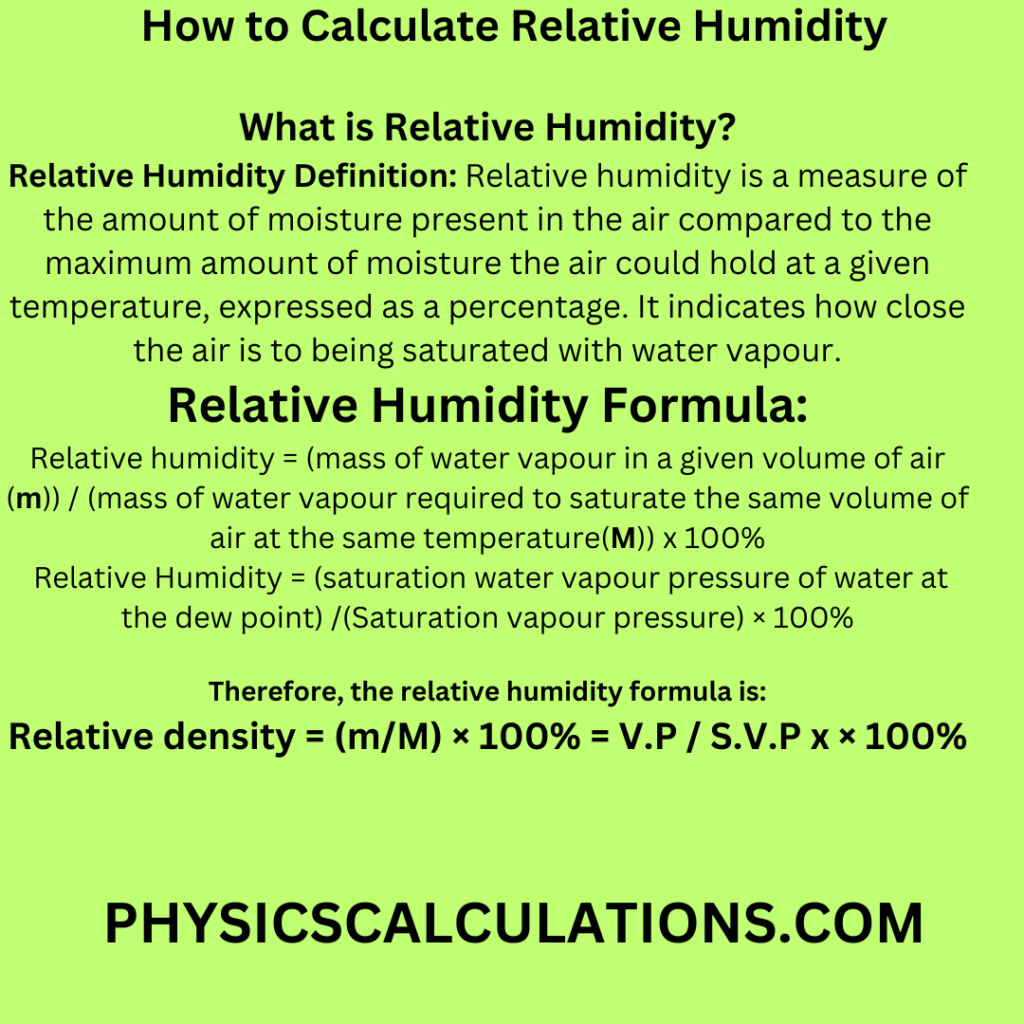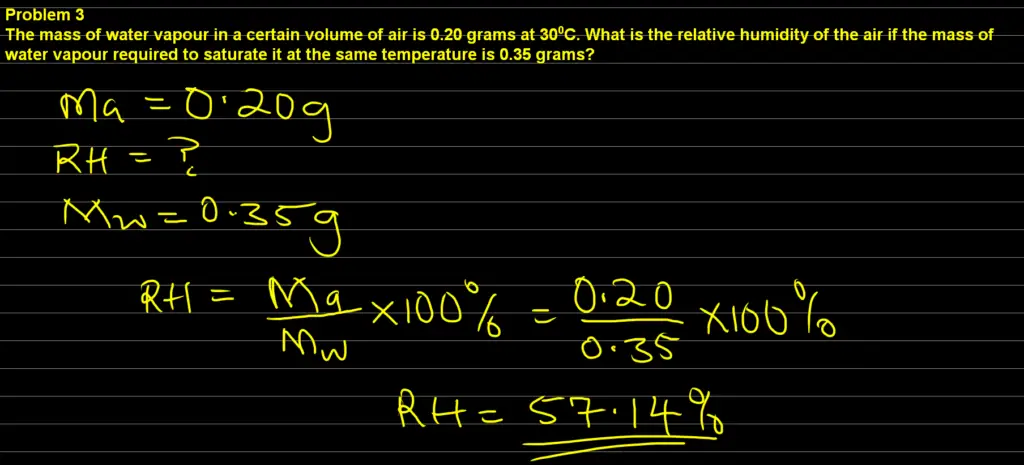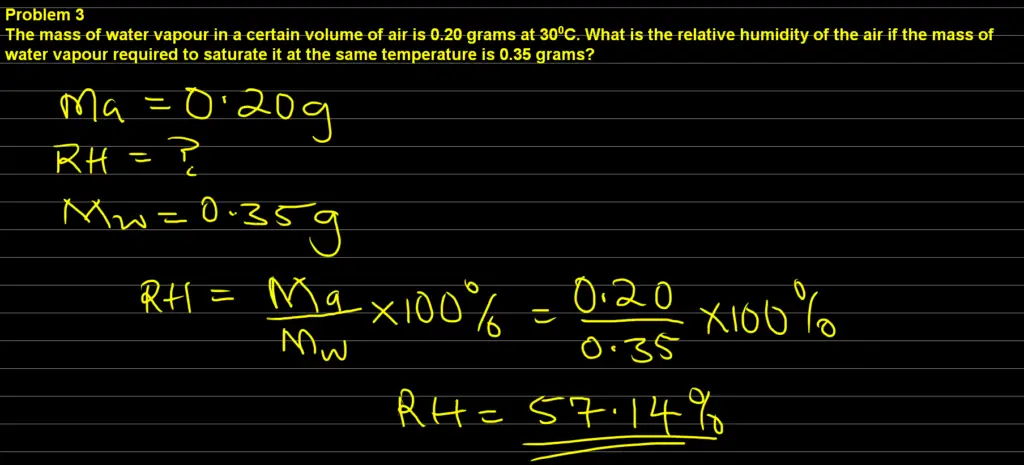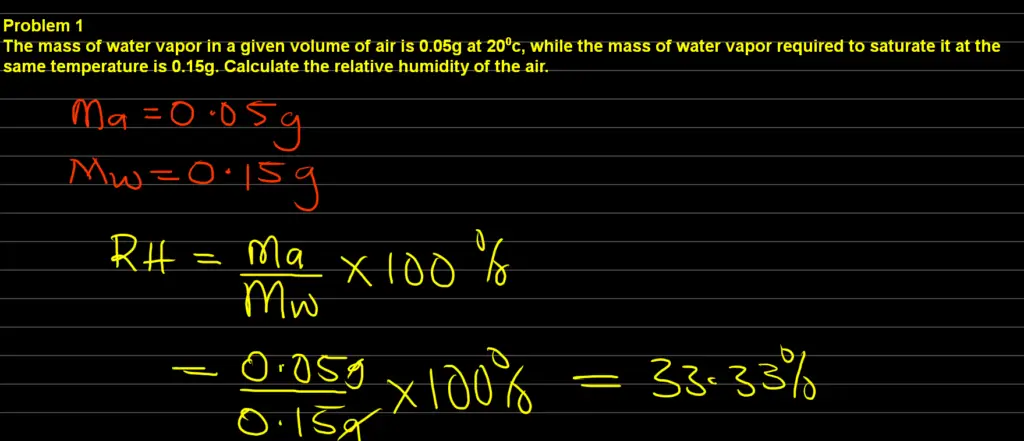
Relative Humidity Definition: Relative humidity is a measure of the amount of moisture present in the air compared to the maximum amount of moisture the air can hold at a given temperature, expressed as a percentage. It indicates how close the air is to being saturated with water vapour. In this article, you will learn how to calculate relative humidity using a formula.
Please enable JavaScript
The relative humidity formula that we use for calculation are as follows:
First Formula: Relative Humidity (%) = (Actual Vapor Pressure / Saturation Vapor Pressure) × 100
Second Formula: Relative Humidity = [(Vapor pressure (partial pressure) of the air) / (Saturation vapour pressure at the temperature of the air)] × 100%.
Third Formula: Relative Humidity = (specific humidity/saturation vapor pressure) x 100%
Fourth Formula: Relative humidity = [(mass of water vapour in a given volume of air (m)) / (mass of water vapour required to saturate the same volume of air at the same temperature(M))] x 100%
Fifth Formula: Relative Humidity = [(saturation water vapour pressure of water at the dew point) /(Saturation vapour pressure)] × 100%
Relative density = (m/M) × 100% = V.P / S.V.P x × 100%
The final answer for relative humidity is in percentage (%)
Relative humidity measures the amount of moisture present in the air compared to the maximum amount the air can hold at a given temperature.

It is often expressed as a percentage and is a fundamental concept in understanding weather patterns and comfort levels. There are two primary methods for calculating relative humidity
You may also like to check:
Here are a few examples of how to calculate relative humidity using a formula
The mass of water vapor in a given volume of air is 0.05g at 20 0 c, while the mass of water vapor required to saturate it at the same temperature is 0.15g. Calculate the relative humidity of the air.

Solution
Data
Mass of water vapor in a given volume of air, Ma = 0.05g
Mass of water vapor required to saturate it at the same temperature, Mw = 0.15g
Relative humidity of air, Ra = ?
Ra = ( 0.05 / 0.15 ) x 100% = 33.33%
Assuming the actual vapor density is 20g/m 3 at 30 0 c compared to the saturation vapor density at the same temperature of 25g/m 3 . Calculate the relative humidity of the air.

Solution
Data:
Actual vapor density = 20g/m 3
saturation vapor density = 25g/m 3
And the formula is
Relative Humidity = (specific humidity/saturation vapor pressure) x 100%
Relative Humidity = (20/25) x 100% = 0.8 x 100% = 80%
The mass of water vapour in a certain volume of air is 0.20 grams at 30 0 C. What is the relative humidity of the air if the mass of water vapour required to saturate it at the same temperature is 0.35 grams?
Final answer: The relative humidity of the air is 57.14%

Data: Information from the question
Mass of water vapour, m = 0.20 g
The mass of water vapour required for saturation, M = 0.35 g
Unknown: What we need to find
Relative humidity (R.H) = ?
Formula: The equation that will help us solve the problem
Relative humidity = (mass of water vapour in a given volume of air (m)) / (mass of water vapour required to saturate the same volume of air at the same temperature(M)) x 100%
Which can be written as Relative humidity = (m/M) x 100%
Solution
Substituting our formula with our data, we will have
Relative humidity = (m/M) x 100% = (0.2/0.35) x 100% = 57.14%
The table below shows the saturation vapour pressure against in a particular city. If on a certain day, the vapour pressure in this city at 30 0 C is 22.0 mmHg, what is the relative humidity?
Table of vapour vs temperatureSolution
Vapour pressure at 30 0 C, V.P = 22.0 mmHg
Saturated vapour pressure of air at 30 0 C, S.V.P = 31.8 mmHg
Therefore, we will now apply the formula
Relative Humdity = (V.P) / (S.V.P) x 100% = (22.0 / 31.8) x 100% = 69.2%
Therefore, the relative humidity is 69.2%
On a certain day, the dew point is 10 0 C when the temperature of the air is 32 0 C. Calculate the relative humidity of the air .(S.V.P of water at 32 0 C and 10 0 C are 16.2mmHg and 9.8mmHg respectively).
Solution
S.V.P at dew point (10 0 C) = 9.8 mmHg
Also, S.V.P at air temperature (32 0 C) = 16.2 mmHg
Thus, Relative Humdity = (S.V.P at dew point / S.V.P at air temperature) x 100% = (9.8 / 16.2) x 100% = 60.5%
Therefore, the relative humidity of the air is 60.5%
Understanding and accurately calculating relative humidity is essential for various applications:
No, relative humidity and humidity are not the same. Humidity refers to the amount of water vapor in the air, while relative humidity compares the actual moisture content to the maximum amount the air could hold at a given temperature.
Yes, relative humidity can exceed 100% in certain conditions. This occurs when the air is supersaturated with moisture, and condensation begins to form.
For most indoor environments, a relative humidity range of 40% to 60% is considered optimal for human comfort and health.
Higher relative humidity levels can make temperatures feel hotter than they actually are due to reduced evaporative cooling from the skin.
No, relative humidity can vary throughout the day based on temperature changes and other environmental factors.
Materials such as wood and paper can absorb or release moisture based on relative humidity levels, affecting their structural integrity.
You may also like to check:
Check:
Arewagist – Health and Nutrition